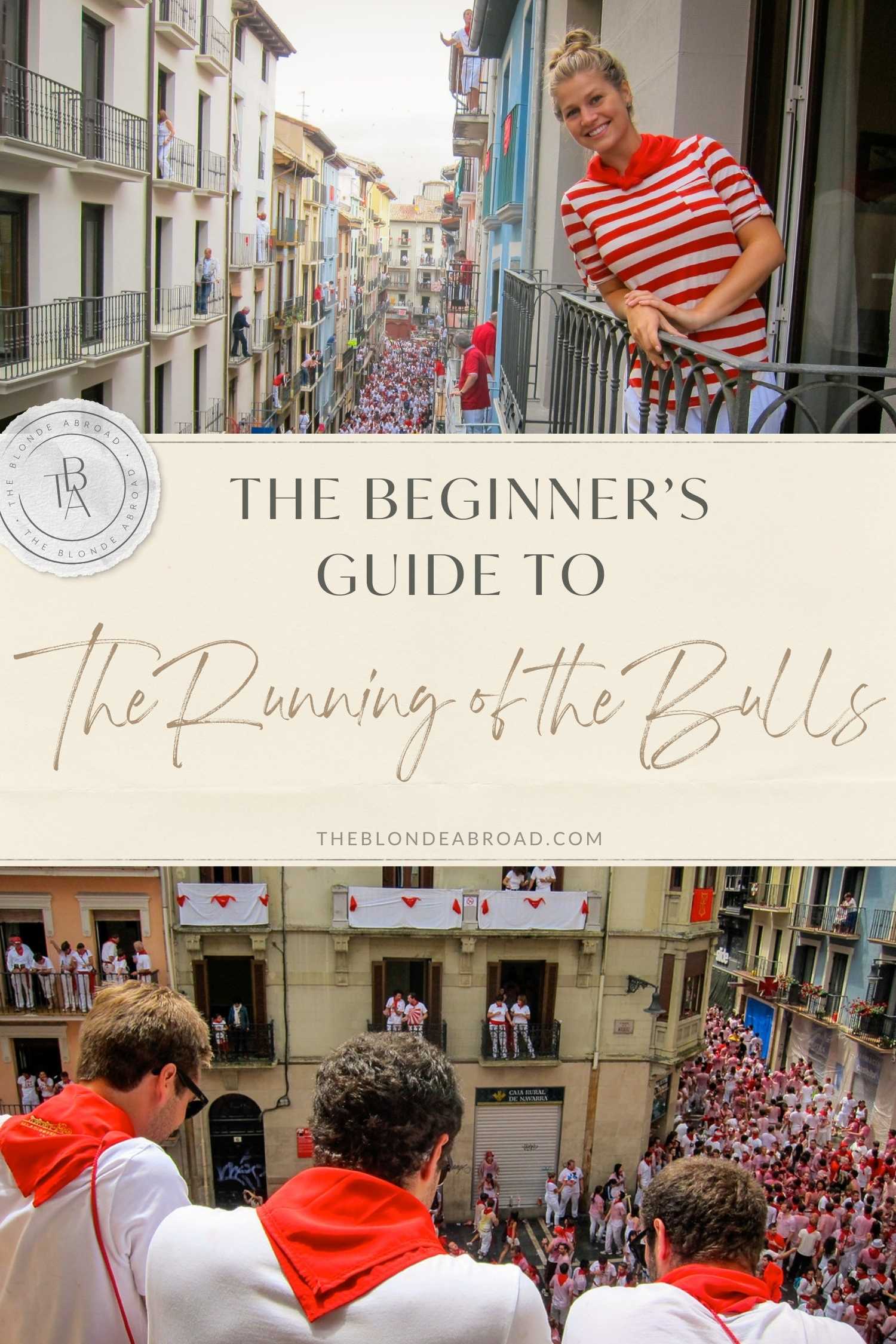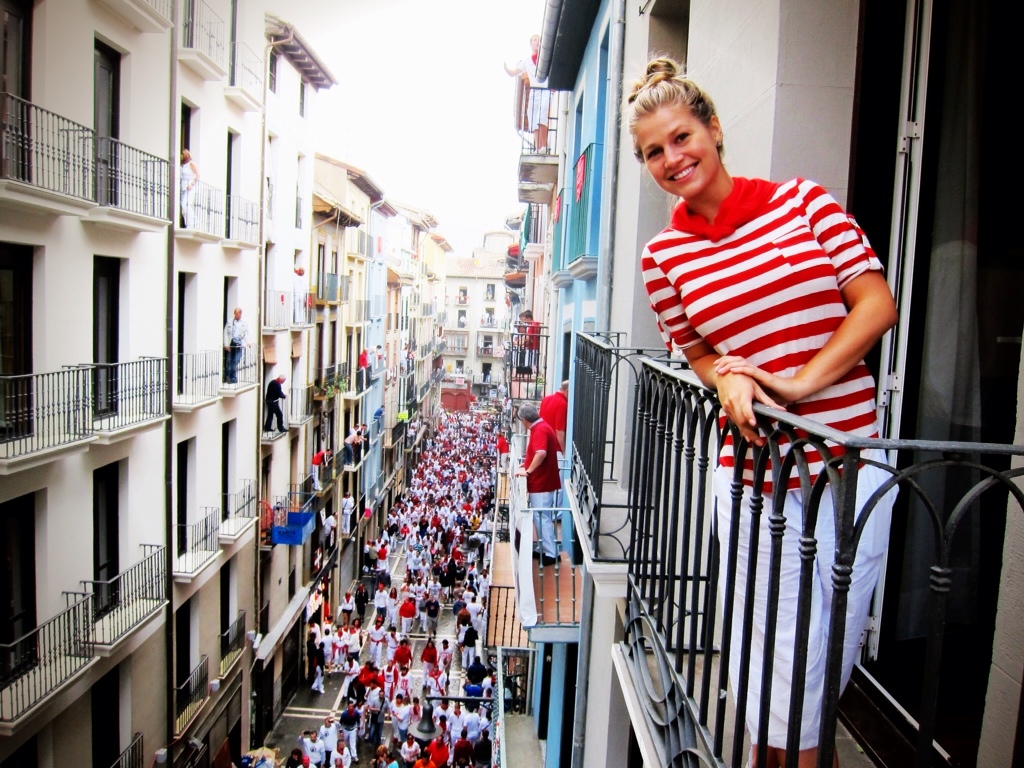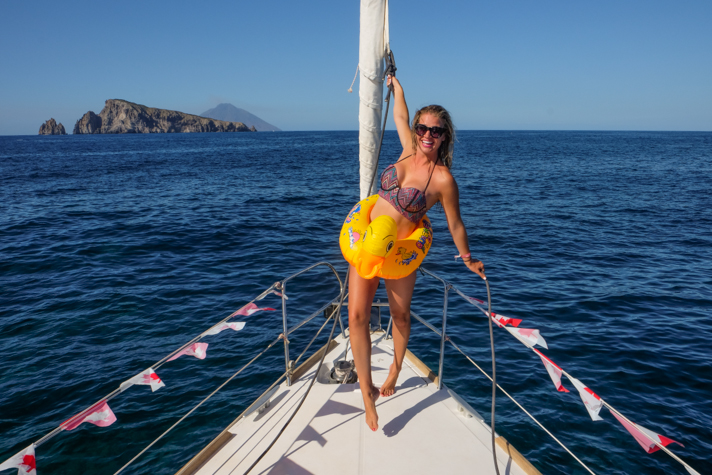
The Running of the Bulls, or Encierro, takes place on the morning of the second day of the San Fermín festival. After a long and eventful first day commencing the festival, including the opening ceremonies, the Running of the Bulls comes in a flash.
Here’s my beginner’s guide to The Running of the Bulls in Pamplona, Spain!

The San Fermín Festival
The San Fermín Festival takes place in Pamplona, Spain every year. You may have never heard of the actual festival but it’s internationally recognized for the famous ‘Running of the Bulls’. It attracts millions of visitors for nine days of festivities and is crowned as Spain’s largest festival!
The opening ceremony, or “Chupinazo,” of the festival takes place in Plaza Consistorial outside of City Hall on the first day. Thousands of people pack themselves into every crevice of the Spanish city to celebrate the commencement of the festival.
The festival officially begins on the first day at noon, it will commence with a firecracker, and everyone absolutely loses it and goes bananas in celebration!
Each night at 11 p.m. during the San Fermín festival, there are firework displays that shame any show I have ever seen. The entire sky is lit up (for almost 30 minutes) with colorful sparks of fire above the ancient Citadel of Pamplona.
The party continues on through the night with high anticipation for the Running of the Bulls the next morning.
The Tradition
So why does this festival exist and what does it mean for the Spanish people?
The tradition dates back to the 13th century and the origins of the annual bull runs are actually based on practicality…and not any sort of festival!
Cattle herders who were transporting their animals from the countryside to the city to sell them needed a way to move their animals.
A tradition grew out of this—a narrow path would be cleared in the city center where the spirited animals could run and be corraled together. With the encouragement from bystanders and people shouting from buildings, the herders were able to speed up the process.
Nobody knows for sure when the exact date was, but it started to become a competition for young men to rush alongside the animals and it became a test of bravado.
It’s believed that the San Fermín Festival and the Running of the Bulls naturally merged together over time. The Festival is associated with the city’s co-patron saint, and given the dangers involved, many revelers and participants ask Saint Fermín for guidance and protection.
Update
I attended this festival a number of years ago. While I’m glad I got to experience it and I think it’s important to highlight cultural practices and traditions around the world, it’s not something I support. It’s something I look back on now that I’m older and wouldn’t go to again.
However, one of the goals with The Blonde Abroad is to highlight other cultures, as different as they may be from our own, rather than gloss over things. I think this is the best way to open up a dialogue about the world around us and in turn, promote positive growth.

The Running of the Bulls
The Running of the Bulls takes place on the second day of the festival, and many people party through the previous night and come for the run still stained in sangria. The streets are cleaned as best as possible while thousands of people begin to fill the streets and balconies along the route of the run.
You will want to get to the main street where the running takes place early, about 7 a.m. to be safe. You’ll have to enter through the gateway at the Town Hall before 7:30 a.m. as the running begins at 8 a.m. promptly. Once the run gets closer to beginning, the police will start separating the crowd and clearing the route.
It’ll get cozy, but there will be lots of cheering and songs to pass the time!
About 15 minutes before the start, the police will start to let the runners take their places and at 8:00 a.m. you’ll hear a loud shotgun! That signifies that the gates holding the bulls has been opened, and a couple minutes later you’ll hear the second shotgun, which means that all the bulls are on the streets and running.
The whole Running with the Bulls event only lasts about four to five minutes, but believe me, the adrenaline will last for hours!

What to Expect
Accommodation: The prices for everything in town during this week, especially the room rates, are massively inflated and every place is booked.
Weather: Pamplona in July is sunny and warm! Expect temperatures in the low 80° F (26° C).
Traditions: Traditionally, women do not run the race. If you’re concerned for your safety, a bird’s eye view is more than satisfactory for a first experience!
Partying: Get ready for nonstop partying from (even before) the opening ceremonies for the following nine days. Sangria galore!

The Rules
Believe it or not, there are actual rules for participating in the Running of the Bulls, and for great reason. The rules are published by the City of Pamplona and are strongly enforced each morning along the bull run route.
If you are found violating these rules, you can be ejected from the bull run, detained, or arrested, depending on the severity of your infraction. The purpose of these rules is to protect yourselves and others from increased risk of injury in an already dangerous situation!
Here are a few key rules:
- The presence on the route of minors under the age of 18, who are absolutely excluded from the right to run or take part.
- Before the bulls are released, waiting in corners, blind spots, doorways or premises located along the route.
- Keeping doors of shops or doorways of houses along the route open, with the owners or tenants of the premises concerned being responsible for ensuring this.
- Remaining on the route in a state of drunkenness, under the effect of drugs or engaging in any other improper behavior.
- Carrying objects deemed unsuitable for the smooth running of the encierro (including any type of camera or video camera).
- Running towards the bulls or running behind them.
Be sure to read all of the rules before attending to keep yourself and others safe!
How to Dress for Running of the Bulls
Traditionally, you should expect to dress in all white and bring a red handkerchief, or “Pañuelo,” to tie around your neck at the sound of a firecracker at noon.
You can find the all-white outfits around town and it will cost you about $20 to buy the whole thing, so that is probably the best option, especially if you’re trying to travel light!
You can go out first thing in the morning (or continue on from last night’s party) dressed from head to toe in white and fit in perfectly.
A note to the wise, expect to end up covered in water, sangria, mustard, soda, eggs…you name it!

My Experience
The whole event seems surreal in hindsight but I’m so glad I went. I got the opportunity to be a part of a cultural experience that has been passed on for hundreds of years.
While the chaos of the small streets filled with thousands of (mostly drunk) people can be overwhelming, I only stayed for the first two days. I got a taste for the San Fermín Festival and was able to leave without feeling like it was too much of a good thing.
READ NEXT: San Fermín Festival: Opening Ceremony & The Running of the Bulls








Bull can die. Event is fun to watch so fun is more important.
” it’s better to talk and share about these kinds of cultural practices, though they might be different from our own, rather than gloss over them. I look back on the festival now that I’m older, and while I’m glad that I got to experience it, I wouldn’t go again. However, I think this is the best way to open up a dialogue about the world around us and in turn, promote positive growth. ” Kiersten Rich, The Blonde Abroad.
Thank you for this statement, therefore, let’s “open up the dialogue” as Kiki suggests and make people aware that at the end of the ‘Running of the Bulls’ these animals are brought into a bullring where they are repeatedly stabbed, harpooned, drugged, and in the end, have their ears cut off – while still conscious- to show to gruesomely display to the horrified crowd – most of which are tourists.
The banderilleros dart around the terrified, bleeding animals while plunging banderillas—brightly colored sticks with a harpoon point on one end—into their already-injured backs. The wounded animals are forced to run in circles, until they stop because they’re too dizzy, disoriented, and weakened from blood loss to continue.
Now let’s continue the dialogue and discuss “tradition”. Is this really “tradition?” Large corporate entities feed their corporate greed as these events are hugely profitable. The problem is that most tourists are not aware of the torture that these animals endure, and naively attend these festivals without understanding the horrific and gruesome deaths that these animals will succumb to – all in the name of “cultural entertainment”
Moreover, more than 100 Spanish towns and cities have banned bullfighting, and a 2016 poll found that 81% of Spaniards ages 16 to 65 oppose it. That figure rises to 93% among 16- to 24-year-olds.
I think it’s important that as global citizens we have accountability for our actions and understand the consequence of our actions; One of the reasons many of us travel is for cultural immersion as a means of better understanding the world. With that understanding, comes more informed, responsible, educated decisions on how we travel, spend our money, and its long-term effects on those beings around us.
Don’t allow our naivety as tourists to be exploited for corporate profit at the expense of the vulnerable beings around us, namely the bulls. Don’t attend this barbaric festival.
I hope my comments are actually posted on this website and not deleted as spam or because they are too controversial. That is not how it was intended. If my comments are deleted, this just just another touristy website, with no depth, and lack of global consciousness.